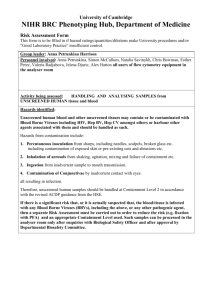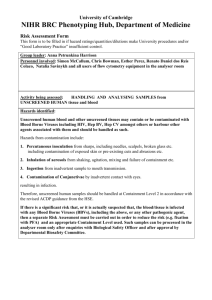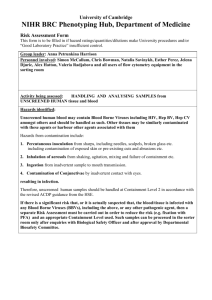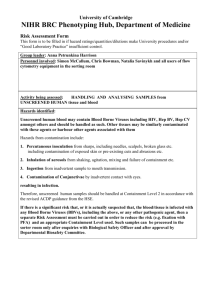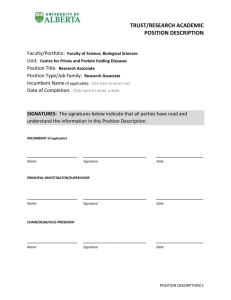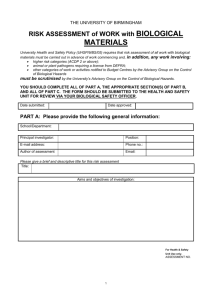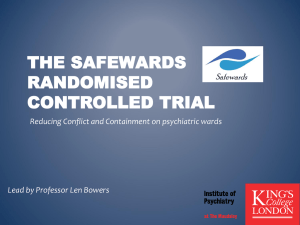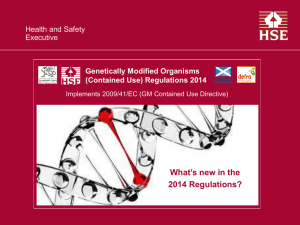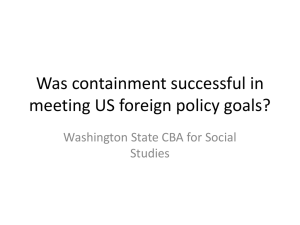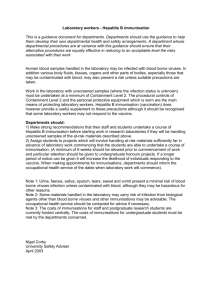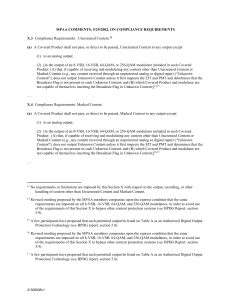3_RA-cat2 analyser room (word format) updated 010915
advertisement
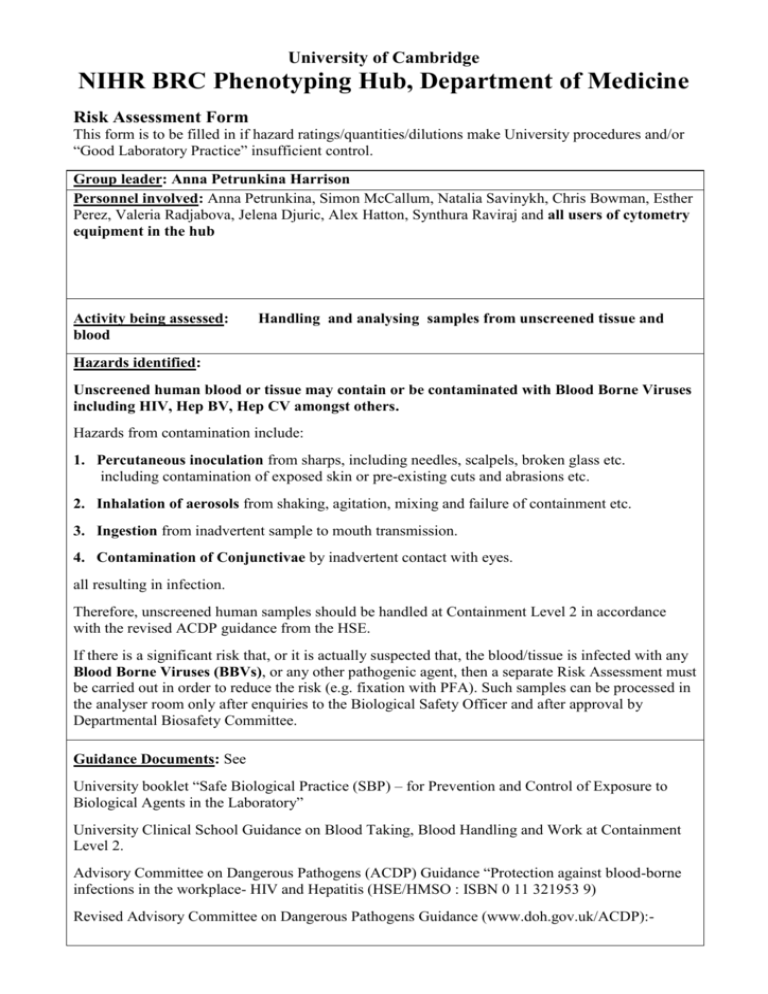
University of Cambridge NIHR BRC Phenotyping Hub, Department of Medicine Risk Assessment Form This form is to be filled in if hazard ratings/quantities/dilutions make University procedures and/or “Good Laboratory Practice” insufficient control. Group leader: Anna Petrunkina Harrison Personnel involved: Anna Petrunkina, Simon McCallum, Natalia Savinykh, Chris Bowman, Esther Perez, Valeria Radjabova, Jelena Djuric, Alex Hatton, Synthura Raviraj and all users of cytometry equipment in the hub Activity being assessed: blood Handling and analysing samples from unscreened tissue and Hazards identified: Unscreened human blood or tissue may contain or be contaminated with Blood Borne Viruses including HIV, Hep BV, Hep CV amongst others. Hazards from contamination include: 1. Percutaneous inoculation from sharps, including needles, scalpels, broken glass etc. including contamination of exposed skin or pre-existing cuts and abrasions etc. 2. Inhalation of aerosols from shaking, agitation, mixing and failure of containment etc. 3. Ingestion from inadvertent sample to mouth transmission. 4. Contamination of Conjunctivae by inadvertent contact with eyes. all resulting in infection. Therefore, unscreened human samples should be handled at Containment Level 2 in accordance with the revised ACDP guidance from the HSE. If there is a significant risk that, or it is actually suspected that, the blood/tissue is infected with any Blood Borne Viruses (BBVs), or any other pathogenic agent, then a separate Risk Assessment must be carried out in order to reduce the risk (e.g. fixation with PFA). Such samples can be processed in the analyser room only after enquiries to the Biological Safety Officer and after approval by Departmental Biosafety Committee. Guidance Documents: See University booklet “Safe Biological Practice (SBP) – for Prevention and Control of Exposure to Biological Agents in the Laboratory” University Clinical School Guidance on Blood Taking, Blood Handling and Work at Containment Level 2. Advisory Committee on Dangerous Pathogens (ACDP) Guidance “Protection against blood-borne infections in the workplace- HIV and Hepatitis (HSE/HMSO : ISBN 0 11 321953 9) Revised Advisory Committee on Dangerous Pathogens Guidance (www.doh.gov.uk/ACDP):- Control measures to reduce the level of risk: Unscreened human samples processed for flow cytometry analysis should be handled at Containment Level 2. In addition to the measures and facilities normally specified for work at Containment Level 2 (see relevant guidance), the additional measures listed below should also apply when Containment Level 2 is specified. • All work must be conducted in a designated containment level 2 work area (all 3 labs in the Phenotyping Hub are now Cl2) with sufficient space to work safely. • Access to CL2 areas is restricted to authorised staff only. Access is enabled via personal ID cards, and transfering/borrowing these cards is not permitted. All users will be advised of the containment level of the workspace, and the necessity of restricting activities to those that are risk assessed. This advice is incorporated in the compulsory induction to the facility • The use of sharps and glassware should be avoided. Where such use is essential, particular care must be taken in their handling and disposal after contact with unfixed materials. All sharps must be disposed of immediately after their use. • Lesions on exposed skin should be covered with waterproof dressings. • Blue labcoats are compulsory in all Cl2 areas, these are provided in each room. Users must not move between labs with blue lab coats on. Users must also wear disposable gloves, which are also provided. Protective eyewear is also provided but not compulsory. These conditions must be stated in the researchers project RA’s. • The workstations must be kept clear of unnecessary equipment and not used for storage. • Care should be taken when exchanging samples on flow analysers; aerosol generation is inevitable during this step as all flow cytometers quickly change between ambient and ~5psi pressure. These aerosols can neither be contained nor prevented. Therefore, no unscreened samples which are not PFA-fixed can be processed in the hub without prior review of Project Risk Assessments with respect to infection via the aerosol route. The analysis of unscreened and unfixed blood/tissue may prove necessary in apoptosis assays or where fixation can be shown to alter staining patterns. Investigators with unscreened samples which are not PFA-treated must seek advice (prior to starting their experiments) from Biological Safety Officer : Dr. Mark Wills. He will assess whether the risk assessment for experiments is adequate, in particular, whether the risk has been sufficiently reduced by additional procedures and factors (e.g. patient risk group, cell isolation, depletion, alternative fixation procedures, viral inactivation, screening for BBV) and refer to the Safety Committee in cases of enhanced risk. In situations where unfixed samples present risk levels above 'low' and the approval of Safety Committee has not been obtained, it may be possible for these samples to be run on MSC contained cell sorters by authorised core facility staff. • The bench surface and any equipment must be disinfected immediately after completion of work. 1) After completion of flow cytometry work, the machines must be cleaned as described in the guidance notes (detergent, followed by water). The waste tank should be supplemented with Virkon tablets in the quantity prescribed for each particular instrument (final concentration of ~1%). NOTE: Virkon must be never used for cleaning equipment! 2) In case of spillages, surface area has to be sprayed with Trigene and wiped. • For all staff entering the flow cytometry area for conducting work, Hep BV vaccine, together with followup procedures, is compulsory. Evidence of innoculation and follow-up must be logged. • Contaminated waste will be disposed of in accordance with local guidance and rules for the safe disposal of Containment Level 2 waste; including chemical sterilisation of liquids with autoclaving and incinerating for solids as appropriate. Level of risk remaining: Low Emergency procedures: NB: See Guidance Documents as above. First Aid: Wash any contaminated skin, conjunctivae or mucous membrane immediately. In the event of a wound, it should be allowed to bleed by irrigation under running water. Seek medical Advice and contact University Occupational Health Service immediately. Spillage: All spillages and surface contamination must be immediately cleaned up and removed including decontamination with a suitable validated disinfectant (10% solution of Trigene). Blockages of the equipment: If an analyser, Hub staff MUST be advised immediately on the nature of the sample, and deblocking procedure must be performed under standard GLP (with syringe and luer lock adapter to inject either 20% decon90 or similar agent) Name and status of assessors: Anna Petrunkina, Simon McCallum Date of assessment: 26/10/2015 Signature of assessor: Revision due date: 01/09/2016
